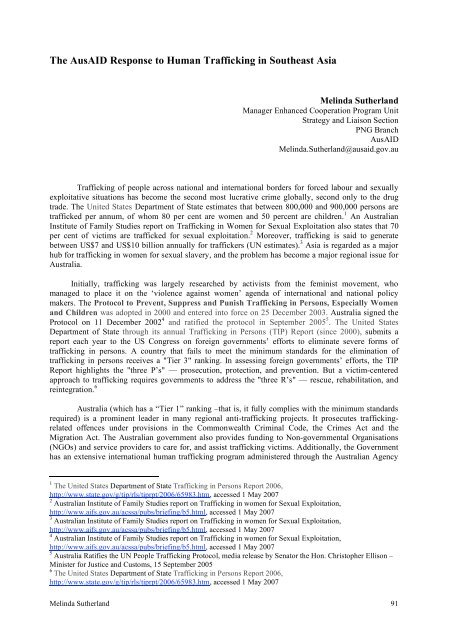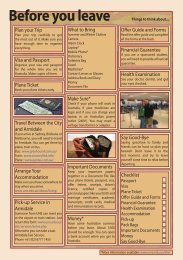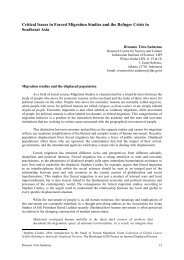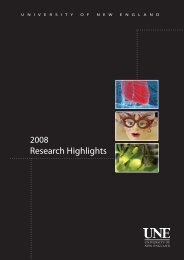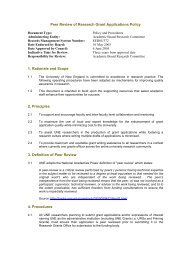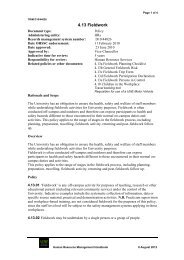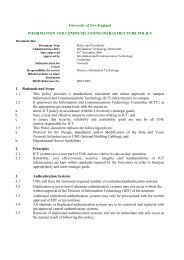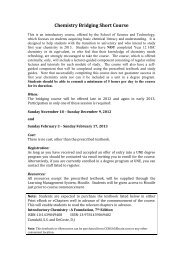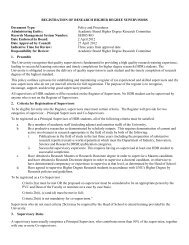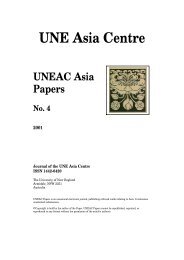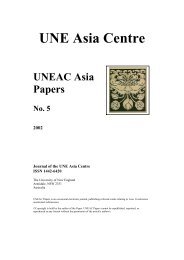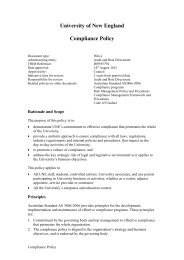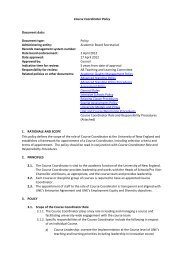The AusAID Response to Human Trafficking in Southeast Asia
The AusAID Response to Human Trafficking in Southeast Asia
The AusAID Response to Human Trafficking in Southeast Asia
Create successful ePaper yourself
Turn your PDF publications into a flip-book with our unique Google optimized e-Paper software.
<strong>The</strong> <strong>AusAID</strong> <strong>Response</strong> <strong>to</strong> <strong>Human</strong> <strong>Traffick<strong>in</strong>g</strong> <strong>in</strong> <strong>Southeast</strong> <strong>Asia</strong><br />
Mel<strong>in</strong>da Sutherland<br />
Manager Enhanced Cooperation Program Unit<br />
Strategy and Liaison Section<br />
PNG Branch<br />
<strong>AusAID</strong><br />
Mel<strong>in</strong>da.Sutherland@ausaid.gov.au<br />
<strong>Traffick<strong>in</strong>g</strong> of people across national and <strong>in</strong>ternational borders for forced labour and sexually<br />
exploitative situations has become the second most lucrative crime globally, second only <strong>to</strong> the drug<br />
trade. <strong>The</strong> United States Department of State estimates that between 800,000 and 900,000 persons are<br />
trafficked per annum, of whom 80 per cent are women and 50 percent are children. 1 An Australian<br />
Institute of Family Studies report on <strong>Traffick<strong>in</strong>g</strong> <strong>in</strong> Women for Sexual Exploitation also states that 70<br />
per cent of victims are trafficked for sexual exploitation. 2 Moreover, traffick<strong>in</strong>g is said <strong>to</strong> generate<br />
between US$7 and US$10 billion annually for traffickers (UN estimates). 3 <strong>Asia</strong> is regarded as a major<br />
hub for traffick<strong>in</strong>g <strong>in</strong> women for sexual slavery, and the problem has become a major regional issue for<br />
Australia.<br />
Initially, traffick<strong>in</strong>g was largely researched by activists from the fem<strong>in</strong>ist movement, who<br />
managed <strong>to</strong> place it on the ‘violence aga<strong>in</strong>st women’ agenda of <strong>in</strong>ternational and national policy<br />
makers. <strong>The</strong> Pro<strong>to</strong>col <strong>to</strong> Prevent, Suppress and Punish <strong>Traffick<strong>in</strong>g</strong> <strong>in</strong> Persons, Especially Women<br />
and Children was adopted <strong>in</strong> 2000 and entered <strong>in</strong><strong>to</strong> force on 25 December 2003. Australia signed the<br />
Pro<strong>to</strong>col on 11 December 2002 4 and ratified the pro<strong>to</strong>col <strong>in</strong> September 2005 5 . <strong>The</strong> United States<br />
Department of State through its annual <strong>Traffick<strong>in</strong>g</strong> <strong>in</strong> Persons (TIP) Report (s<strong>in</strong>ce 2000), submits a<br />
report each year <strong>to</strong> the US Congress on foreign governments’ efforts <strong>to</strong> elim<strong>in</strong>ate severe forms of<br />
traffick<strong>in</strong>g <strong>in</strong> persons. A country that fails <strong>to</strong> meet the m<strong>in</strong>imum standards for the elim<strong>in</strong>ation of<br />
traffick<strong>in</strong>g <strong>in</strong> persons receives a "Tier 3" rank<strong>in</strong>g. In assess<strong>in</strong>g foreign governments’ efforts, the TIP<br />
Report highlights the "three P’s" — prosecution, protection, and prevention. But a victim-centered<br />
approach <strong>to</strong> traffick<strong>in</strong>g requires governments <strong>to</strong> address the "three R’s" — rescue, rehabilitation, and<br />
re<strong>in</strong>tegration. 6<br />
Australia (which has a “Tier 1” rank<strong>in</strong>g –that is, it fully complies with the m<strong>in</strong>imum standards<br />
required) is a prom<strong>in</strong>ent leader <strong>in</strong> many regional anti-traffick<strong>in</strong>g projects. It prosecutes traffick<strong>in</strong>grelated<br />
offences under provisions <strong>in</strong> the Commonwealth Crim<strong>in</strong>al Code, the Crimes Act and the<br />
Migration Act. <strong>The</strong> Australian government also provides fund<strong>in</strong>g <strong>to</strong> Non-governmental Organisations<br />
(NGOs) and service providers <strong>to</strong> care for, and assist traffick<strong>in</strong>g victims. Additionally, the Government<br />
has an extensive <strong>in</strong>ternational human traffick<strong>in</strong>g program adm<strong>in</strong>istered through the Australian Agency<br />
1 <strong>The</strong> United States Department of State <strong>Traffick<strong>in</strong>g</strong> <strong>in</strong> Persons Report 2006,<br />
http://www.state.gov/g/tip/rls/tiprpt/2006/65983.htm, accessed 1 May 2007<br />
2 Australian Institute of Family Studies report on <strong>Traffick<strong>in</strong>g</strong> <strong>in</strong> women for Sexual Exploitation,<br />
http://www.aifs.gov.au/acssa/pubs/brief<strong>in</strong>g/b5.html, accessed 1 May 2007<br />
3 Australian Institute of Family Studies report on <strong>Traffick<strong>in</strong>g</strong> <strong>in</strong> women for Sexual Exploitation,<br />
http://www.aifs.gov.au/acssa/pubs/brief<strong>in</strong>g/b5.html, accessed 1 May 2007<br />
4 Australian Institute of Family Studies report on <strong>Traffick<strong>in</strong>g</strong> <strong>in</strong> women for Sexual Exploitation,<br />
http://www.aifs.gov.au/acssa/pubs/brief<strong>in</strong>g/b5.html, accessed 1 May 2007<br />
5 Australia Ratifies the UN People <strong>Traffick<strong>in</strong>g</strong> Pro<strong>to</strong>col, media release by Sena<strong>to</strong>r the Hon. Chris<strong>to</strong>pher Ellison –<br />
M<strong>in</strong>ister for Justice and Cus<strong>to</strong>ms, 15 September 2005<br />
6 <strong>The</strong> United States Department of State <strong>Traffick<strong>in</strong>g</strong> <strong>in</strong> Persons Report 2006,<br />
http://www.state.gov/g/tip/rls/tiprpt/2006/65983.htm, accessed 1 May 2007<br />
Mel<strong>in</strong>da Sutherland 91
for International Development (<strong>AusAID</strong>). Australia’s overseas aid package is designed <strong>to</strong> support<br />
several develop<strong>in</strong>g countries <strong>in</strong> the region <strong>to</strong> overcome the deplorable trade <strong>in</strong> human be<strong>in</strong>gs and<br />
particularly focuses on countries <strong>in</strong> the Mekong subregion - Cambodia, Ch<strong>in</strong>a (Yunnan Prov<strong>in</strong>ce), Lao<br />
People’s Democratic Republic (Lao PDR), Burma (Myanmar), Thailand and Vietnam. It has provided<br />
A$12 million (2004-7) through <strong>AusAID</strong> for its <strong>Asia</strong> Regional Cooperation <strong>to</strong> Prevent People<br />
<strong>Traffick<strong>in</strong>g</strong> project (ARCPPT). Through this project, the Australian government enhances capabilities<br />
of governments <strong>in</strong> prevention and support activities for victims of traffick<strong>in</strong>g.<br />
Australia and anti-traffick<strong>in</strong>g <strong>in</strong>itiatives <strong>in</strong> the region<br />
<strong>AusAID</strong> is the government agency with the primary responsibility for adm<strong>in</strong>ister<strong>in</strong>g official<br />
development assistance overseas. <strong>AusAID</strong> advises the Government on development policy and<br />
manages Australian development cooperation programs designed <strong>to</strong> achieve broad-based growth,<br />
stability and effective governance, particularly <strong>in</strong> the <strong>Asia</strong>- Pacific region. <strong>The</strong> objective of Australia’s<br />
overseas aid program is <strong>to</strong> assist develop<strong>in</strong>g countries <strong>to</strong> reduce poverty and achieve susta<strong>in</strong>able<br />
development, <strong>in</strong> l<strong>in</strong>e with Australia’s national <strong>in</strong>terest. 7 This paper documents the activities of <strong>AusAID</strong><br />
<strong>in</strong> this regard, focuss<strong>in</strong>g on the ARCPPT Project, the International Organisation for Migration (IOM)<br />
Return and Re<strong>in</strong>tegration of Trafficked Women and Children Project, the IOM Pilot Thai Returnees<br />
Project, a number of Child Wise Tourism Projects, and the upcom<strong>in</strong>g <strong>Asia</strong> Regional <strong>Traffick<strong>in</strong>g</strong> <strong>in</strong><br />
Persons (ARTIP) Project. As well, this paper documents <strong>AusAID</strong>s assessment of a project design<br />
document for the Timor-Leste IOM/Alola Foundation - Halt Exploitation and Learn <strong>to</strong> Prosecute<br />
(HELP) Counter-<strong>Traffick<strong>in</strong>g</strong> Project.<br />
At the dawn of the new millennium, the Australian Government recognised that Australia was<br />
not immune from the problems that neighbour<strong>in</strong>g countries are experienc<strong>in</strong>g <strong>in</strong> human traffick<strong>in</strong>g. In<br />
2003 the Government committed A$20 million over a period of four years <strong>to</strong> combat the problem of<br />
human traffick<strong>in</strong>g nationally. 8 Australia uses a whole-of-government approach <strong>to</strong> addresses traffick<strong>in</strong>g<br />
through the coord<strong>in</strong>ated efforts of several government agencies. In June 2004 M<strong>in</strong>isters from five<br />
federal government agencies, represent<strong>in</strong>g law, justice, foreign affairs, immigration and women’s<br />
affairs, released a national Action Plan <strong>to</strong> Eradicate <strong>Traffick<strong>in</strong>g</strong> <strong>in</strong> Persons, provid<strong>in</strong>g details of<br />
Australia’s national commitment <strong>to</strong> combat traffick<strong>in</strong>g. 9<br />
Fund<strong>in</strong>g for the national package is separate from the significant funds provided <strong>to</strong> develop<strong>in</strong>g<br />
countries <strong>in</strong> the region through official development assistance. <strong>AusAID</strong>s human traffick<strong>in</strong>g program is<br />
adm<strong>in</strong>istered through the <strong>Asia</strong> Transboundary Section. <strong>The</strong> <strong>Asia</strong> Transboundary Section focuses on<br />
<strong>in</strong>ternational development issues that are not restricted or conf<strong>in</strong>ed <strong>to</strong> borders and are transnational by<br />
nature. Other transboundary activities adm<strong>in</strong>istered by the section <strong>in</strong>clude HIV/AIDS prevention;<br />
pandemic preparedness for diseases such as avian <strong>in</strong>fluenza; counterterrorism measures; and the trade <strong>in</strong><br />
illegal drugs.<br />
Australia’s anti-traffick<strong>in</strong>g activities <strong>in</strong> <strong>Southeast</strong> <strong>Asia</strong> adopt a holistic approach. All projects<br />
address both adult women and child victims of traffick<strong>in</strong>g, and do not differentiate between sex<br />
traffick<strong>in</strong>g and other forms of traffick<strong>in</strong>g such as labour exploitation. Australian assistance is targeted at<br />
enhanc<strong>in</strong>g the capabilities of organisations and <strong>in</strong>dividuals <strong>to</strong> support traffick<strong>in</strong>g victims, especially<br />
women. <strong>The</strong> assistance <strong>in</strong>cludes improved sub-regional and national communication and cooperation<br />
efforts, particularly through legal, adm<strong>in</strong>istrative, policy and advocacy measures.<br />
7 Australian Aid: Promot<strong>in</strong>g Growth and Stability - White Paper on the Australian Government's overseas aid<br />
program,, <strong>AusAID</strong> 2007, page (x)<br />
8 Australian Institute of Family Studies report on <strong>Traffick<strong>in</strong>g</strong> <strong>in</strong> women for Sexual Exploitation,<br />
http://www.aifs.gov.au/acssa/pubs/brief<strong>in</strong>g/b5.html, accessed 1 May 2007<br />
9 Millar Carol<strong>in</strong>e 2006, Combat<strong>in</strong>g <strong>Traffick<strong>in</strong>g</strong> In Persons: Australian Approaches <strong>to</strong> National and Regional<br />
Cooperation, Journal of International and Comparative Law special edition (Spr<strong>in</strong>g 2006), page 1<br />
UNEAC <strong>Asia</strong> Papers No. 19 2007 92
<strong>AusAID</strong> recognises that a range of activities are required <strong>to</strong> prevent the traffick<strong>in</strong>g of women<br />
and children, such as warn<strong>in</strong>g potential victims about traffick<strong>in</strong>g activities, enhanc<strong>in</strong>g country capacity<br />
enabl<strong>in</strong>g <strong>in</strong>vestigations <strong>to</strong> be successfully conducted, ensur<strong>in</strong>g the existence of appropriate and effective<br />
laws <strong>to</strong> enable suspected offenders <strong>to</strong> be charged, and ensur<strong>in</strong>g <strong>in</strong>vestigat<strong>in</strong>g and prosecut<strong>in</strong>g agencies<br />
are suitably skilled and resourced <strong>to</strong> facilitate successful prosecutions. Support<strong>in</strong>g the return and<br />
successful re<strong>in</strong>tegration of traffick<strong>in</strong>g victims is similarly complex, and <strong>in</strong>volves significant efforts <strong>to</strong><br />
encourage victims <strong>to</strong> access available services, as well as ensur<strong>in</strong>g that governments, non-governmental<br />
organisations (NGOs) and other relevant bodies have sufficient capacity <strong>to</strong> provide appropriate services<br />
<strong>to</strong> ensure successful re<strong>in</strong>tegration.<br />
<strong>Asia</strong> Regional Cooperation <strong>to</strong> Prevent People <strong>Traffick<strong>in</strong>g</strong> Project (ARCPPT)<br />
At present the ARCPPT is the largest anti-traffick<strong>in</strong>g project funded by <strong>AusAID</strong>. <strong>The</strong> regional<br />
project was valued at A$12 million and extended over 3 years (March 2003 <strong>to</strong> August 2006). <strong>The</strong><br />
project’s aims were <strong>to</strong> contribute <strong>to</strong> the prevention of human traffick<strong>in</strong>g <strong>in</strong> <strong>Southeast</strong> <strong>Asia</strong>. Partner<br />
Governments <strong>in</strong>cluded Thailand, Lao PDR, Cambodia and Burma (Myanmar). While these countries<br />
have rema<strong>in</strong>ed the primary geographical focus of ARCPPT, some activities have also been conducted <strong>in</strong><br />
Indonesia and, <strong>to</strong> a lesser extent, <strong>in</strong> Ch<strong>in</strong>a, Vietnam and the Philipp<strong>in</strong>es. This project was fully funded<br />
by <strong>AusAID</strong> and was implemented by CARDNO (ACIL), a well known company conduct<strong>in</strong>g a number<br />
of projects <strong>in</strong> the development sec<strong>to</strong>r.<br />
ARCPPTs longer-term objectives are <strong>to</strong> reduce the impunity of traffick<strong>in</strong>g offenders and secure<br />
justice for victims. <strong>The</strong> project aims <strong>to</strong> build on the work that is already be<strong>in</strong>g done <strong>in</strong> the field and <strong>to</strong><br />
tailor efforts specifically <strong>to</strong> meet <strong>in</strong>dividual country needs. It attempts <strong>to</strong> strengthen regional<br />
cooperation and legal policy frameworks through identified ASEAN + Ch<strong>in</strong>a (Yunnan Prov<strong>in</strong>ce)<br />
national counterpart po<strong>in</strong>ts of contact, and <strong>to</strong> build national and regional capacity <strong>to</strong> address human<br />
traffick<strong>in</strong>g. ARCPPT provides support <strong>in</strong> four areas:<br />
• Support <strong>to</strong> specialist law enforcement<br />
Specialist anti-traffick<strong>in</strong>g units have been established <strong>in</strong> national counterpart law enforcement<br />
agencies <strong>in</strong> all ARCPPT countries <strong>The</strong> Project is build<strong>in</strong>g on this new impetus by provid<strong>in</strong>g access <strong>to</strong><br />
<strong>in</strong>ternational best practice on combat<strong>in</strong>g traffick<strong>in</strong>g through strengthened law enforcement. <strong>The</strong> project<br />
supports strategies <strong>to</strong> develop communication and collaboration between the specialist anti-traffick<strong>in</strong>g<br />
units across national borders. It is expected that, over time, the units will become ‘anchor po<strong>in</strong>ts’ for<br />
successful national and regional strategies aga<strong>in</strong>st traffickers.<br />
• Support <strong>to</strong> the broader crim<strong>in</strong>al justice process<br />
Outside the specialist law enforcement units, ARCPPT provides assistance and support <strong>to</strong> other<br />
relevant parts of the crim<strong>in</strong>al justice system <strong>to</strong> ensure that improvements are not adversely affected by<br />
ongo<strong>in</strong>g weaknesses elsewhere <strong>in</strong> the crim<strong>in</strong>al justice system. <strong>The</strong> project support <strong>to</strong> other parts of the<br />
crim<strong>in</strong>al justice systems of each country is provided where required, on the basis of a detailed<br />
assessment of needs and capacities. For example, support for cooperation and <strong>in</strong>formation exchanges<br />
between different components of the crim<strong>in</strong>al justice system is required <strong>in</strong> some countries, while others<br />
may require support for law reform.<br />
• Cooperation between the crim<strong>in</strong>al justice process and victim support agencies<br />
ARCPPT recognises the vital role that victims play <strong>in</strong> secur<strong>in</strong>g prosecutions and the importance<br />
of victim support agencies <strong>in</strong> provid<strong>in</strong>g support <strong>to</strong> traffick<strong>in</strong>g victims. <strong>The</strong> project facilitates and<br />
promotes cooperation and collaboration between the law enforcement agencies and the victim support<br />
agencies. <strong>The</strong> project also promotes transnational collaboration and cooperation between the victim<br />
support agencies <strong>in</strong> all of the project countries.<br />
•Strengthened regional cooperation<br />
In addition <strong>to</strong> the regional and transboundary activities, ARCPPT <strong>in</strong>itiates activities aimed at<br />
promot<strong>in</strong>g closer cooperation and collaboration between project countries and other member countries<br />
Mel<strong>in</strong>da Sutherland 93
of ASEAN + Ch<strong>in</strong>a. Activities <strong>in</strong>clude support for the development and implementation of Memoranda<br />
of Understand<strong>in</strong>g (MOUs) and other formal cooperation agreements that promote cooperation and<br />
collaboration amongst the governments. 10<br />
ARCPPT also works closely with the Association of <strong>Southeast</strong> <strong>Asia</strong>n Nations (ASEAN)<br />
Secretariat (ASEC) on issues and activities of common <strong>in</strong>terest relat<strong>in</strong>g <strong>to</strong> human traffick<strong>in</strong>g. Through<br />
the ASEC, ARCPPT also works closely with the Senior Officials Meet<strong>in</strong>g on Transnational Organised<br />
Crime (SOMTC). <strong>The</strong> ARCPPT has achieved significant progress <strong>in</strong> each project country. 11 A summary<br />
of achievements <strong>to</strong> date is provided <strong>in</strong> Appendix A. <strong>The</strong> Project received a positive mid-term-review<br />
that was <strong>in</strong>dependently conducted <strong>in</strong> 2004. Subject <strong>to</strong> M<strong>in</strong>isterial approval, it is anticipated that a<br />
follow-on project, described further below, will be tendered by <strong>AusAID</strong> <strong>to</strong> build on the achievements of<br />
the ARCPPT <strong>in</strong> the current project countries and expand activities <strong>to</strong> other countries <strong>in</strong> the region.<br />
Return and Re<strong>in</strong>tegration of Victims<br />
<strong>AusAID</strong> funds two return and re<strong>in</strong>tegration activities, Phase I and II of the IOM Return and<br />
Re<strong>in</strong>tegration of Trafficked Women and Children and the Thai Returnees Pilot Project. Both activities<br />
are delivered through the IOM. <strong>The</strong> IOM has extensive global experience <strong>in</strong> assist<strong>in</strong>g with the return<br />
and re<strong>in</strong>tegration of traffick<strong>in</strong>g victims, and is responsible for implement<strong>in</strong>g the Mekong-based regional<br />
return and re<strong>in</strong>tegration activity.<br />
Phase I and II of IOM Return and Re<strong>in</strong>tegration of Trafficked Women and Children<br />
Phase I and II of this project aim <strong>to</strong> establish susta<strong>in</strong>able support mechanisms and structures for<br />
the identification, return, recovery and <strong>in</strong>tegration of victims <strong>in</strong> and between selected Mekong<br />
countries. Phase I (2000-2004) was fully funded by Australia and was valued at approximatelyA$4.7<br />
million. <strong>The</strong> project is currently <strong>in</strong> Phase II (March 2004 – February 2007) Phase II is primarily funded<br />
by the US Bureau of Population, Refugees and Migration. Australian assistance <strong>to</strong> this phase is<br />
currently valued at approximately A$665,000. <strong>The</strong> goal of the Phase II is <strong>to</strong> develop susta<strong>in</strong>able support<br />
mechanisms and structures for the identification, return, recovery and <strong>in</strong>tegration of victims of<br />
traffick<strong>in</strong>g with<strong>in</strong> government and NGO agencies <strong>in</strong> and between selected countries <strong>in</strong> the Mekong<br />
region such as Thailand, Cambodia, Vietnam, Burma (Myanmar) and Lao PDR. <strong>The</strong> project aims <strong>to</strong><br />
strengthen the ability of partners <strong>in</strong>volved, both government and non-governmental, <strong>to</strong> provide<br />
assistance <strong>to</strong> victims and promote necessary regional cooperation <strong>to</strong> counter traffick<strong>in</strong>g through legal,<br />
adm<strong>in</strong>istrative, policy and advocacy measures. <strong>AusAID</strong>s fund<strong>in</strong>g is specifically used <strong>to</strong> strengthen the<br />
capacity of government agencies, organisations and NGOs <strong>in</strong> Lao PDR and Burma (Myanmar) <strong>to</strong><br />
provide recovery, orderly return and <strong>in</strong>tegration assistance for trafficked women and children, and <strong>to</strong><br />
cooperate nationally and across borders between send<strong>in</strong>g and receiv<strong>in</strong>g countries on issues related <strong>to</strong><br />
return and <strong>in</strong>tegration of victims of traffick<strong>in</strong>g. 12 Accord<strong>in</strong>g <strong>to</strong> progress reports submitted by IOM <strong>to</strong><br />
<strong>AusAID</strong> 13 , from September 2000 <strong>to</strong> February 2006 the Regional Return and Re<strong>in</strong>tegration <strong>in</strong>itiative has<br />
assisted 1511 traffick<strong>in</strong>g victims <strong>in</strong> the Mekong region. S<strong>in</strong>ce Phase II commenced, the project has<br />
supported 626 victims with their return and re<strong>in</strong>tegration. Of this group, 377 women and children from<br />
Lao PDR and Burma (Myanmar) received assistance.<br />
Thai Returnees Pilot Project<br />
<strong>The</strong> IOM project for Thai returnees is a pilot project for victims identified <strong>in</strong> Australia return<strong>in</strong>g<br />
<strong>to</strong> Thailand. <strong>AusAID</strong> recently contracted IOM <strong>to</strong> develop and manage the pilot project from Thailand.<br />
<strong>The</strong> pilot project between Australia and Thailand was developed on the basis that the majority of<br />
victims located <strong>in</strong> Australia so far have been Thai. This activity recognises that Thailand has ga<strong>in</strong>ed<br />
10 <strong>Asia</strong> Regional Cooperation <strong>to</strong> Prevent People <strong>Traffick<strong>in</strong>g</strong>: Annual Plan 2005-2006 approved by <strong>AusAID</strong>, 2005,<br />
Page 27<br />
11 <strong>Asia</strong> Regional Cooperation <strong>to</strong> Prevent People <strong>Traffick<strong>in</strong>g</strong>: Activity Completion Report <strong>to</strong> <strong>AusAID</strong>, 2006<br />
12 Return and Re<strong>in</strong>tegration of Trafficked Women and Children – Phase II Progress Report <strong>to</strong> <strong>AusAID</strong>, 2006, p.3<br />
13 Return and Re<strong>in</strong>tegration of Trafficked Women and Children – Phase II Progress Report <strong>to</strong> <strong>AusAID</strong>, 2006, p.4<br />
UNEAC <strong>Asia</strong> Papers No. 19 2007 94
considerable experience <strong>in</strong> assist<strong>in</strong>g Thai traffick<strong>in</strong>g victims over the past decade and has worked<br />
steadily <strong>to</strong> improve its domestic response <strong>to</strong> traffick<strong>in</strong>g.<br />
Thailand has the necessary legal and policy framework as well as a considerable bureaucracy<br />
and a strong network of NGOs work<strong>in</strong>g on the prevention of traffick<strong>in</strong>g, <strong>in</strong> association with the<br />
Government. For example, the Department of Social Development and Welfare operates a significant<br />
number of traffick<strong>in</strong>g shelters for victims throughout Thailand <strong>to</strong> provide support and care for <strong>in</strong>ternal<br />
and <strong>in</strong>ternational returnees. 14<br />
<strong>The</strong> new project will focus on target<strong>in</strong>g three groups of traffick<strong>in</strong>g victims, namely, those<br />
•Identified victims of traffick<strong>in</strong>g or potential victims who are will<strong>in</strong>g <strong>to</strong> cooperate with <strong>in</strong>vestigat<strong>in</strong>g<br />
agencies and who have consented <strong>to</strong> their <strong>in</strong>formation be<strong>in</strong>g shared with the Thai Government’s<br />
representation <strong>in</strong> Australia (that is, those will<strong>in</strong>g <strong>to</strong> cooperate with Govt of Australia and Thailand);<br />
•Identified victims of traffick<strong>in</strong>g or potential victims who are will<strong>in</strong>g <strong>to</strong> cooperate with <strong>in</strong>vestigat<strong>in</strong>g<br />
agencies, but who do not consent <strong>to</strong> their <strong>in</strong>formation be<strong>in</strong>g shared with the Thai Government’s<br />
representation <strong>in</strong> Australia (that is, those will<strong>in</strong>g <strong>to</strong> cooperate with Govt of Australia but not Thailand);<br />
and<br />
•Identified victims of traffick<strong>in</strong>g or potential victims who do not want <strong>to</strong> cooperate with <strong>in</strong>vestigat<strong>in</strong>g<br />
authorities and who do not give consent <strong>to</strong> their <strong>in</strong>formation be<strong>in</strong>g shared with Thai Government<br />
representatives <strong>in</strong> Australia (that is, those unwill<strong>in</strong>g <strong>to</strong> cooperate with either Government).<br />
Those <strong>in</strong> the second and third categories are of particular concern, as the obligation <strong>to</strong> access<br />
re<strong>in</strong>tegration assistance rests on their own <strong>in</strong>itiative follow<strong>in</strong>g return. <strong>The</strong> new program will undertake a<br />
number of activities <strong>to</strong> encourage victims <strong>to</strong> seek re<strong>in</strong>tegration assistance. <strong>The</strong> activities <strong>in</strong>clude<br />
strengthen<strong>in</strong>g <strong>in</strong>formation dissem<strong>in</strong>ation and peer support networks; improv<strong>in</strong>g access <strong>to</strong> vocational<br />
tra<strong>in</strong><strong>in</strong>g and jobs-referrals; and provid<strong>in</strong>g access <strong>to</strong> legal services. A targeted <strong>in</strong>formation campaign<br />
<strong>in</strong>volv<strong>in</strong>g the distribution of pr<strong>in</strong>t materials will also be conducted.<br />
For victims who choose <strong>to</strong> return home without support, a nom<strong>in</strong>al amount of money equivalent<br />
<strong>to</strong> approximately one month’s rent will be provided through the IOM. <strong>The</strong>re is one condition of<br />
access<strong>in</strong>g this support, namely that the return<strong>in</strong>g victim must <strong>in</strong>itiate contact with a specified NGO <strong>to</strong><br />
collect the money. This will enable the NGO <strong>to</strong> advise the returnee on the different support services<br />
available, and will serve as encouragement for the victims <strong>to</strong> seek re<strong>in</strong>tegration support.<br />
While this project is still be<strong>in</strong>g put <strong>in</strong> place, return and re<strong>in</strong>tegration arrangements are<br />
coord<strong>in</strong>ated for Thai traffick<strong>in</strong>g victims <strong>in</strong> Australia through the Australian Federal Police and the<br />
Department of Family and Community Services and Indigenous Affairs (Office for Women).<br />
Department of Family and Community Services and Indigenous Affairs contracted a company,<br />
Southern Edge Tra<strong>in</strong><strong>in</strong>g, <strong>to</strong> facilitate victim return and re<strong>in</strong>tegration as a component of Australia’s<br />
national response <strong>to</strong> human traffick<strong>in</strong>g.<br />
Child Wise Projects<br />
Child Wise Project: Prevent<strong>in</strong>g the Sexual Exploitation of Children <strong>in</strong> ASEAN Tourism Dest<strong>in</strong>ations<br />
through Community and Professional Education<br />
This two year regional Project aims <strong>to</strong> establish “Child Wise Tourism” Pr<strong>in</strong>ciples <strong>in</strong> the work of<br />
National Tourism Adm<strong>in</strong>istrations of develop<strong>in</strong>g countries so that they cont<strong>in</strong>ue <strong>to</strong> work regionally <strong>in</strong><br />
the prevention of child sex <strong>to</strong>urism. <strong>AusAID</strong> is fund<strong>in</strong>g the $590,000 Project and it will run from<br />
January 2005 <strong>to</strong> January 2007. This is a follow-on project that modified the previous focus <strong>to</strong> reduce the<br />
vulnerability of children as a result of the Tsunami and <strong>in</strong> the longer-term as <strong>to</strong>urists beg<strong>in</strong> <strong>to</strong> return <strong>to</strong><br />
14 IOM Project Design Document for the Regional Pilot Project for Return<strong>in</strong>g Victims of <strong>Traffick<strong>in</strong>g</strong> from<br />
Australia <strong>to</strong> Thailand, <strong>AusAID</strong> 2006, p.5<br />
Mel<strong>in</strong>da Sutherland 95
the affected countries. Participat<strong>in</strong>g countries <strong>in</strong>clude Thailand, Vietnam, Cambodia, the Philipp<strong>in</strong>es,<br />
Indonesia, Lao PDR and Burma (Myanmar). 15<br />
Child Wise Project: Child Wise ASEAN Regional Education Campaign<br />
Accord<strong>in</strong>g <strong>to</strong> <strong>AusAID</strong>s <strong>in</strong>ternal statistics, Child Wise (ECPAT) has received more than $1.45<br />
million s<strong>in</strong>ce 1994 through <strong>AusAID</strong> as part of the Australian Government’s efforts <strong>to</strong> build <strong>in</strong>stitutional<br />
and legal capacity <strong>in</strong> the region <strong>to</strong> fight child sex crime. 16<br />
An advertis<strong>in</strong>g campaign has been developed <strong>to</strong> combat child sex <strong>to</strong>urism <strong>in</strong> ASEAN countries.<br />
<strong>The</strong> campaign is targeted at <strong>to</strong>urists and those work<strong>in</strong>g <strong>in</strong> the <strong>to</strong>urism sec<strong>to</strong>r. <strong>The</strong> advertis<strong>in</strong>g will<br />
encourage locals <strong>to</strong> turn <strong>in</strong> suspected child sex offenders and the campaign will appear <strong>in</strong> prime <strong>to</strong>urist<br />
dest<strong>in</strong>ations <strong>in</strong>clud<strong>in</strong>g hotels, airl<strong>in</strong>es, <strong>in</strong>ternet cafes, travel agencies, taxis and tuk tuks. <strong>AusAID</strong> is<br />
contribut<strong>in</strong>g $50,000 for the production and purchase of advertis<strong>in</strong>g materials for the ASEAN countries.<br />
<strong>The</strong> ASEAN countries are self-fund<strong>in</strong>g the runn<strong>in</strong>g campaign with<strong>in</strong> their respective countries utilis<strong>in</strong>g<br />
the materials provided by Child Wise. 17<br />
Future <strong>AusAID</strong> <strong>Traffick<strong>in</strong>g</strong> Projects<br />
In the future, <strong>AusAID</strong> may expand its pilot Thai Returnees project from Thailand <strong>to</strong> other<br />
<strong>Southeast</strong> <strong>Asia</strong>n countries, depend<strong>in</strong>g on whether victim demographics <strong>in</strong> Australia change over time.<br />
<strong>AusAID</strong> is likely <strong>to</strong> cont<strong>in</strong>ue fund<strong>in</strong>g for Child-Wise activities <strong>to</strong> prevent the sexual exploitation of<br />
children <strong>in</strong> ASEAN <strong>to</strong>urism dest<strong>in</strong>ations through community and professional education activities.<br />
<strong>AusAID</strong> will cont<strong>in</strong>ue <strong>to</strong> fund other bilateral projects that protect women and children from<br />
problems that lead <strong>to</strong> traffick<strong>in</strong>g, abuse and exploitation. For example, a number of child protection<br />
projects <strong>in</strong> the region, not detailed <strong>in</strong> this paper, are currently funded by <strong>AusAID</strong>. 18 <strong>AusAID</strong> is also<br />
provid<strong>in</strong>g significant support <strong>to</strong> develop<strong>in</strong>g countries <strong>in</strong> <strong>Asia</strong> and the Pacific <strong>to</strong> strengthen law and<br />
justice <strong>in</strong>stitutions and systems. 19<br />
<strong>Asia</strong> Regional <strong>Traffick<strong>in</strong>g</strong> In Persons (ARTIP) Project<br />
<strong>AusAID</strong> <strong>in</strong>tends on expand<strong>in</strong>g on the achievements of the ARCPPT project <strong>in</strong><strong>to</strong> other ASEAN<br />
countries <strong>in</strong> a separate follow-on project. In 2005 a new, five year $21 million project known as the<br />
<strong>Asia</strong> Regional <strong>Traffick<strong>in</strong>g</strong> <strong>in</strong> Persons (ARTIP) Project was designed <strong>to</strong> follow-on from ARCPPT<br />
without a gap. 20 A handover from ARCPPT <strong>to</strong> ARTIP will be conducted <strong>in</strong> August 2006. ARTIP will<br />
assist countries <strong>in</strong> the <strong>Asia</strong> region <strong>to</strong> tackle the problem of human traffick<strong>in</strong>g by expand<strong>in</strong>g on the<br />
build<strong>in</strong>g blocks laid by the current project.<br />
<strong>The</strong> goal of the new project will be expanded <strong>to</strong> contribute <strong>to</strong> the prevention of human<br />
traffick<strong>in</strong>g <strong>in</strong> the <strong>Asia</strong> Region, not just the countries <strong>in</strong> the Greater Mekong Sub-Region. <strong>The</strong> purpose of<br />
the Project will be <strong>to</strong> be facilitate a more effective and coord<strong>in</strong>ated approach <strong>to</strong> people traffick<strong>in</strong>g by<br />
crim<strong>in</strong>al justice systems of participat<strong>in</strong>g national governments <strong>in</strong> the <strong>Asia</strong>. Partner countries <strong>in</strong> the<br />
project will <strong>in</strong>clude Thailand, Lao PDR, Cambodia, Burma (Myanmar) & Indonesia. <strong>The</strong> project will<br />
commence activities <strong>in</strong> partner countries when they formally agree <strong>to</strong> the project be<strong>in</strong>g conducted <strong>in</strong><br />
15 Prevent<strong>in</strong>g the Sexual Exploitation of Children <strong>in</strong> ASEAN Tourism Dest<strong>in</strong>ations through Community and<br />
Professional Education: Child Wise Annual Progress Report Year 2 <strong>to</strong> <strong>AusAID</strong>, February 2006, page 3<br />
16 This figure is based on <strong>in</strong>ternal statistics provided by <strong>AusAID</strong> <strong>to</strong> another government department on 6 May<br />
2005.<br />
17 Turn a Child-Sex Tourist <strong>in</strong><strong>to</strong> an Ex-Tourist: A Proposal <strong>to</strong> Seek Australian Government Fund<strong>in</strong>g <strong>to</strong> Support a<br />
Public Education Campaign <strong>to</strong> Support Children, November 2005, page 5<br />
18 People <strong>Traffick<strong>in</strong>g</strong> and Child Exploitation: Australia's Aid Program <strong>Response</strong>,<br />
http://www.ausaid.gov.au/country/peopletraffick.cfm, accessed 1 May 2007<br />
19 Australian Aid: Promot<strong>in</strong>g Growth and Stability - White Paper on the Australian Government's overseas aid<br />
program, <strong>AusAID</strong> 2007, http://www.ausaid.gov.au/publications/whitepaper/s5.htm#5.2, accessed 1 May 2007<br />
20 Project Design Document: <strong>Asia</strong> Regional <strong>Traffick<strong>in</strong>g</strong> In Persons, <strong>AusAID</strong> 2006, p1<br />
UNEAC <strong>Asia</strong> Papers No. 19 2007 96
their country. ARTIP will expand <strong>to</strong> <strong>in</strong>clude other ASEAN countries at a rate of no more than one per<br />
year.<br />
<strong>The</strong> Project will be comprised of the follow<strong>in</strong>g five components: Strengthened specialist and<br />
general law enforcement responses <strong>to</strong> traffick<strong>in</strong>g; Strengthened judicial and prosecu<strong>to</strong>rial responses <strong>to</strong><br />
traffick<strong>in</strong>g; Enhanced policy, legal, research and outreach capability; Engagement of new Project and<br />
partner countries; and Project management. 21<br />
<strong>The</strong> concept of a follow-on activity orig<strong>in</strong>ated dur<strong>in</strong>g the Mid-Term Review (MTR) of<br />
ARCPPT <strong>in</strong> November 2004, where a cont<strong>in</strong>uation of project activities was recommended. <strong>AusAID</strong><br />
subsequently contracted CARDNO (ACIL) <strong>to</strong> prepare a project design document. Fieldwork for the<br />
design was conducted dur<strong>in</strong>g July/August 2005. Prior <strong>to</strong> agree<strong>in</strong>g <strong>to</strong> the project design, <strong>AusAID</strong><br />
conducted a rigorous appraisal process that <strong>in</strong>cluded both <strong>in</strong>ternal and external evaluation by specialists<br />
<strong>in</strong> the fields of human traffick<strong>in</strong>g, gender, law and justice, relevant country programs, and project<br />
design etc.<br />
ARTIP is designed for five years, with cont<strong>in</strong>uation of the Project after the third year subject <strong>to</strong><br />
the f<strong>in</strong>d<strong>in</strong>gs of an <strong>in</strong>dependent mid-term review (MTR). <strong>The</strong> ma<strong>in</strong> issues <strong>in</strong> design<strong>in</strong>g ARTIP were <strong>to</strong><br />
deepen and broaden the current focus while ma<strong>in</strong>ta<strong>in</strong><strong>in</strong>g quality, manage geographical expansion<br />
without compromis<strong>in</strong>g prior achievements, promote susta<strong>in</strong>ability through <strong>in</strong>creased counterpart<br />
responsibility, make the most effective use of long and short-term technical expertise, improve<br />
cooperation with ASEAN and promote donor coord<strong>in</strong>ation <strong>in</strong>clud<strong>in</strong>g common standards. 22<br />
ARTIP has been designed <strong>to</strong> build on ARCPPTs work that strengthened the crim<strong>in</strong>al justice<br />
responses <strong>to</strong> traffick<strong>in</strong>g at national and regional levels. 23 <strong>The</strong> focus on front l<strong>in</strong>e law enforcement will<br />
be cont<strong>in</strong>ued but there is more attention <strong>to</strong> build<strong>in</strong>g prosecu<strong>to</strong>rial and judicial capacities. Support <strong>to</strong> the<br />
legal/regula<strong>to</strong>ry framework will broaden <strong>to</strong> <strong>in</strong>clude, for example, labour exploitation, money<br />
launder<strong>in</strong>g, extra-terri<strong>to</strong>rial provisions of traffick<strong>in</strong>g laws, extradition and mutual legal assistance<br />
mechanisms. ARTIP will use its <strong>in</strong>fluence, expertise and networks <strong>to</strong> facilitate cutt<strong>in</strong>g edge research<br />
and promote donor <strong>in</strong>volvement and coord<strong>in</strong>ation. ARTIP will also strengthen l<strong>in</strong>ks with ASEAN <strong>to</strong><br />
further develop the ASEAN Secretariat and the Senior Official’s Meet<strong>in</strong>g on Transnational Crime<br />
capacities <strong>to</strong> progress the issue of traffick<strong>in</strong>g. ARTIP will focus on support<strong>in</strong>g ASEAN implementation<br />
of its own policies and work plans.<br />
Geographically, ARTIP will start with an <strong>in</strong>itial core group of five countries comprised of the<br />
ARCPPT four plus Indonesia. <strong>The</strong> project design document 24 has identified Indonesia as a core country<br />
because of its previous, highly productive l<strong>in</strong>ks with ARCPPT; the recent establishment of an antitraffick<strong>in</strong>g<br />
unit <strong>in</strong> the Indonesia National Police; the existence of a strong collaborative support<br />
structure <strong>in</strong>volv<strong>in</strong>g the International Organisation for Migration; its membership of ASEAN and f<strong>in</strong>ally,<br />
a severe and worsen<strong>in</strong>g <strong>in</strong>ternal and transboundary traffick<strong>in</strong>g problem that <strong>in</strong>creas<strong>in</strong>gly <strong>in</strong>volves other<br />
countries <strong>in</strong> the region. It is <strong>in</strong>tended that expansion beyond this core group will be graduated and<br />
differentiated <strong>to</strong> preserve achievements secured through ARCPPT. It is expected that expansion will be<br />
based on detailed, medium-term assessments us<strong>in</strong>g a range of mechanisms <strong>in</strong>clud<strong>in</strong>g trial activities.<br />
ASEAN countries that are not eligible <strong>to</strong> receive Australian Overseas Development Assistance,<br />
such as Malaysia, will be <strong>in</strong>volved <strong>in</strong> ARTIP through a range of strategic activities <strong>to</strong> l<strong>in</strong>k these<br />
countries <strong>to</strong> members through strengthen<strong>in</strong>g bilateral relationships. Stronger regional <strong>in</strong>tegration will be<br />
promoted along with greater susta<strong>in</strong>ability, <strong>in</strong>creased cost-effectiveness, greater f<strong>in</strong>ancial control and<br />
accountability, and <strong>in</strong>creased <strong>in</strong>volvement of national counterparts.<br />
21 Project Design Document: <strong>Asia</strong> Regional <strong>Traffick<strong>in</strong>g</strong> In Persons, <strong>AusAID</strong> 2006, p3-4<br />
22 Project Design Document: <strong>Asia</strong> Regional <strong>Traffick<strong>in</strong>g</strong> In Persons, <strong>AusAID</strong> 2006, p2<br />
23 Project Design Document: <strong>Asia</strong> Regional <strong>Traffick<strong>in</strong>g</strong> In Persons, <strong>AusAID</strong> 2006, p1<br />
24 Project Design Document: <strong>Asia</strong> Regional <strong>Traffick<strong>in</strong>g</strong> In Persons, <strong>AusAID</strong> 2006, p3<br />
Mel<strong>in</strong>da Sutherland 97
ARTIP will be managed and will operate from a regional office <strong>in</strong> Bangkok. A satellite office<br />
will be established <strong>in</strong> Jakarta <strong>to</strong> manage national, sub-regional and ASEAN aspects of project<br />
implementation. Each core country will have a country office located with<strong>in</strong> the ma<strong>in</strong> counterpart<br />
agency. <strong>The</strong> country office will support and work closely with national Technical Work<strong>in</strong>g Groups<br />
established by counterparts <strong>to</strong> guide project implementation at the national level. A dedicated<br />
<strong>in</strong>ternational technical adviser will be assigned <strong>to</strong> each country office <strong>to</strong> ensure effective function<strong>in</strong>g of<br />
the Technical Work<strong>in</strong>g Groups and national offices. <strong>The</strong> Adviser will be based <strong>in</strong>-country for an <strong>in</strong>itial<br />
period while new procedures are put <strong>in</strong><strong>to</strong> place and tested. A small team of long-term <strong>in</strong>ternational<br />
technical advisers will <strong>in</strong>clude regional police and judicial/prosecu<strong>to</strong>rial experts. Short-term technical<br />
<strong>in</strong>puts will cover, but not be limited <strong>to</strong>, law enforcement, transnational crime matters and targeted<br />
research.<br />
ARTIP will be work<strong>in</strong>g with<strong>in</strong> a sec<strong>to</strong>r that is volatile and politicised. As a result the project is<br />
regarded as a high-risk activity. Past experiences will be used <strong>to</strong> mitigate all risks and strategies will be<br />
developed <strong>to</strong> mitigate the risks. <strong>The</strong>re are two key risks that the project will need <strong>to</strong> mitigate 25 :<br />
•Counterpart ownership of the Project will be <strong>in</strong>creased <strong>in</strong> ARTIP through a range of measures such as<br />
the devolution of certa<strong>in</strong> responsibilities. Risks associated with this approach <strong>in</strong>clude a lack of capacity<br />
for counterparts <strong>to</strong> take on additional responsibility and an adverse result may be a reduction <strong>in</strong><br />
commitment.<br />
•<strong>The</strong> geographical expansion of ARTIP carries risks, as project expansion may impact on ARCPPT<br />
achievements and relationships. Conversely, expansion br<strong>in</strong>gs more benefits than risks <strong>to</strong> project<br />
countries, <strong>in</strong>clud<strong>in</strong>g a greater access <strong>to</strong> resolve bilateral issues and the opportunity <strong>to</strong> more broadly<br />
share knowledge and experience.<br />
Timor-Leste IOM/Alola Foundation - Halt Exploitation and Learn <strong>to</strong> Prosecute (HELP) Counter-<br />
<strong>Traffick<strong>in</strong>g</strong> Project<br />
<strong>AusAID</strong> is currently consider<strong>in</strong>g fund<strong>in</strong>g a one year, USD$286,186 counter-traffick<strong>in</strong>g project<br />
<strong>in</strong> Timor-Leste with IOM and the Alola Foundation. 26 <strong>The</strong> project has been designed by IOM and the<br />
Alola Foundation <strong>to</strong>: conduct tra<strong>in</strong><strong>in</strong>g and awareness rais<strong>in</strong>g activities for police, lawyers, judiciary,<br />
NGO and Dili-based embassy staff and Timorese consular officers and other relevant Government staff;<br />
develop and implement a broad awareness rais<strong>in</strong>g campaign also target<strong>in</strong>g at-risk Timorese populations,<br />
and transfer skills of IOM staff <strong>to</strong> Alola Foundation staff through a scheme of men<strong>to</strong>r<strong>in</strong>g, close<br />
coord<strong>in</strong>ation and jo<strong>in</strong>t plann<strong>in</strong>g.<br />
If funded this Project would complement a number of other counter-traffick<strong>in</strong>g <strong>in</strong>itiatives<br />
currently underway <strong>in</strong> Timor-Leste. Both the Alola Foundation and IOM will work <strong>to</strong>ward the<br />
ratification of the Pro<strong>to</strong>col <strong>to</strong> Prevent, Suppress and Punish <strong>Traffick<strong>in</strong>g</strong> <strong>in</strong> Persons, Especially Women<br />
and Children, Supplement<strong>in</strong>g the United Nations Convention Aga<strong>in</strong>st Transnational Crime 2000; the<br />
development of a separate law <strong>in</strong> relation <strong>to</strong> traffick<strong>in</strong>g that focuses on victim protection and<br />
re<strong>in</strong>tegration; and the f<strong>in</strong>alisation of Standard Operat<strong>in</strong>g Procedures for the Immigration division of the<br />
PNTL <strong>in</strong> relation <strong>to</strong> traffick<strong>in</strong>g victims.<br />
This project would establish a Women’s’ Legal Resource Centre (‘WLRC’) that would act as a<br />
‘one-s<strong>to</strong>p shop’ where women can receive legal advice, <strong>in</strong>formation and counsell<strong>in</strong>g <strong>in</strong> relation <strong>to</strong> a<br />
number of issues, <strong>in</strong>clud<strong>in</strong>g domestic violence, sexual assault, other crim<strong>in</strong>al matters, immigration,<br />
employment disputes and human traffick<strong>in</strong>g issues. Once operational, the WLRC would provide legal<br />
advice and a referral service for traffick<strong>in</strong>g victims. <strong>The</strong> WLRC would also provide ongo<strong>in</strong>g advocacy<br />
for traffick<strong>in</strong>g victims.<br />
25 Project Design Document: <strong>Asia</strong> Regional <strong>Traffick<strong>in</strong>g</strong> In Persons, <strong>AusAID</strong> 2006, p5<br />
26<br />
Project Design Document: Timor-Leste IOM/Alola Foundation - Halt Exploitation and Learn <strong>to</strong> Prosecute<br />
(HELP) Counter-<strong>Traffick<strong>in</strong>g</strong> Project, <strong>AusAID</strong> 2006, p1<br />
UNEAC <strong>Asia</strong> Papers No. 19 2007 98
It is <strong>in</strong>tended that the project conduct extensive tra<strong>in</strong><strong>in</strong>g and awareness-rais<strong>in</strong>g on the issue of<br />
human traffick<strong>in</strong>g with<strong>in</strong> law enforcement agencies, the legal sec<strong>to</strong>r, civil society groups, other<br />
government agencies and the broader public. Awareness-rais<strong>in</strong>g activities for the general public are also<br />
expected <strong>to</strong> <strong>in</strong>clude components specifically designed for segments of the population at risk of be<strong>in</strong>g<br />
trafficked from Timor-Leste for sexual or labour exploitation.<br />
This paper has documented <strong>AusAID</strong> funded projects, a number of which have attracted world<br />
renowned, significant results and success and has considered <strong>AusAID</strong>s assessment of a project design<br />
document for the Timor-Leste IOM/Alola Foundation - Halt Exploitation and Learn <strong>to</strong> Prosecute<br />
(HELP) Counter-<strong>Traffick<strong>in</strong>g</strong> Project. Th<strong>in</strong>gs are thus set <strong>to</strong> change with the Federal Government’s<br />
packages that are aimed at help<strong>in</strong>g the victims and target<strong>in</strong>g the traffickers.<br />
Bibliography<br />
<strong>Asia</strong> Regional Cooperation <strong>to</strong> Prevent People <strong>Traffick<strong>in</strong>g</strong>: Activity Completion Report <strong>to</strong> <strong>AusAID</strong>,<br />
2006<br />
<strong>Asia</strong> Regional Cooperation <strong>to</strong> Prevent People <strong>Traffick<strong>in</strong>g</strong>: Annual Plan 2005-2006 approved by<br />
<strong>AusAID</strong>, 2005<br />
Australian Aid: Promot<strong>in</strong>g Growth and Stability - White Paper on the Australian Government's<br />
overseas aid program, <strong>AusAID</strong> 2007<br />
Australian Institute of Family Studies report on <strong>Traffick<strong>in</strong>g</strong> <strong>in</strong> women for Sexual Exploitation,<br />
http://www.aifs.gov.au/acssa/pubs/brief<strong>in</strong>g/b5.html, accessed 1 May 2007<br />
Australia Ratifies the UN People <strong>Traffick<strong>in</strong>g</strong> Pro<strong>to</strong>col, media release by Sena<strong>to</strong>r the Hon. Chris<strong>to</strong>pher<br />
Ellison – M<strong>in</strong>ister for Justice and Cus<strong>to</strong>ms, 15 September 2005<br />
IOM Project Design Document for the Regional Pilot Project for Return<strong>in</strong>g Victims of <strong>Traffick<strong>in</strong>g</strong> from<br />
Australia <strong>to</strong> Thailand, <strong>AusAID</strong> 2006<br />
Millar Carol<strong>in</strong>e 2006, Combat<strong>in</strong>g <strong>Traffick<strong>in</strong>g</strong> <strong>in</strong> Persons: Australian Approaches <strong>to</strong> National and<br />
Regional Cooperation, Journal of International and Comparative Law special edition (Spr<strong>in</strong>g<br />
2006)<br />
People <strong>Traffick<strong>in</strong>g</strong> and Child Exploitation: Australia's Aid Program <strong>Response</strong>,<br />
http://www.ausaid.gov.au/country/peopletraffick.cfm, accessed 1 May 2007<br />
Prevent<strong>in</strong>g the Sexual Exploitation of Children <strong>in</strong> ASEAN Tourism Dest<strong>in</strong>ations through Community<br />
and Professional Education: Child Wise Annual Progress Report Year 2 <strong>to</strong> <strong>AusAID</strong>, February<br />
2006<br />
Project Design Document: <strong>Asia</strong> Regional <strong>Traffick<strong>in</strong>g</strong> <strong>in</strong> Persons, <strong>AusAID</strong> 2006<br />
Project Design Document: Timor-Leste IOM/Alola Foundation - Halt Exploitation and Learn <strong>to</strong><br />
Prosecute (HELP) Counter-<strong>Traffick<strong>in</strong>g</strong> Project, <strong>AusAID</strong> 2006<br />
Return and Re<strong>in</strong>tegration of Trafficked Women and Children – Phase II Progress Report <strong>to</strong> <strong>AusAID</strong>,<br />
2006<br />
<strong>The</strong> United States Department of State <strong>Traffick<strong>in</strong>g</strong> <strong>in</strong> Persons Report 2006,<br />
http://www.state.gov/g/tip/rls/tiprpt/2006/65983.htm, accessed 1 May 2007<br />
Turn a Child-Sex Tourist <strong>in</strong><strong>to</strong> an Ex-Tourist: A Proposal <strong>to</strong> Seek Australian Government Fund<strong>in</strong>g <strong>to</strong><br />
Support a Public Education Campaign <strong>to</strong> Support Children, November 2005<br />
Mel<strong>in</strong>da Sutherland 99
Appendix A – Summary of ARCPPT achievements <strong>to</strong> date by area, country and year 27<br />
Benefit Indica<strong>to</strong>rs<br />
Quantity Year Description<br />
1. Knowledge and skills of specialist crim<strong>in</strong>al justice personnel<br />
24 2005 Police tra<strong>in</strong>ed <strong>in</strong> regional sett<strong>in</strong>g (MIC Course 2005)<br />
9, 49, 25 2004,05,06 Cambodian <strong>in</strong>vestiga<strong>to</strong>rs tra<strong>in</strong>ed <strong>in</strong> generic and basic <strong>in</strong>vestigation skills<br />
(English, BI, CSE)<br />
57 2005 Cambodian <strong>in</strong>vestiga<strong>to</strong>rs tra<strong>in</strong>ed <strong>in</strong> specialist human traffick<strong>in</strong>g <strong>in</strong>vestigation<br />
skills<br />
27 2006 Cambodian <strong>in</strong>vestiga<strong>to</strong>rs who par<strong>to</strong>ok <strong>in</strong> the evaluation workshop (TED)<br />
99, 62, 34 2003, 04, 05 Lao <strong>in</strong>vestiga<strong>to</strong>rs tra<strong>in</strong>ed <strong>in</strong> generic and basic <strong>in</strong>vestigation skills<br />
48 2005 Lao <strong>in</strong>vestiga<strong>to</strong>rs tra<strong>in</strong>ed <strong>in</strong> specialist human traffick<strong>in</strong>g <strong>in</strong>vestigation skills<br />
21 2005 Lao <strong>in</strong>vestiga<strong>to</strong>rs tra<strong>in</strong>ed as tra<strong>in</strong>ers<br />
30 2006 Lao <strong>in</strong>vestiga<strong>to</strong>rs who par<strong>to</strong>ok <strong>in</strong> the evaluation workshop (TED)<br />
35, 36, 28 2003, 04, 05 Myanmar <strong>in</strong>vestiga<strong>to</strong>rs tra<strong>in</strong>ed <strong>in</strong> generic and basic <strong>in</strong>vestigation skills<br />
36 2004 Myanmar <strong>in</strong>vestiga<strong>to</strong>rs tra<strong>in</strong>ed <strong>in</strong> generic and basic <strong>in</strong>vestigation skills<br />
28 2005 Myanmar <strong>in</strong>vestiga<strong>to</strong>rs tra<strong>in</strong>ed <strong>in</strong> generic and basic <strong>in</strong>vestigation skills<br />
36, 28 2004, 2005 Myanmar <strong>in</strong>vestiga<strong>to</strong>rs tra<strong>in</strong>ed <strong>in</strong> specialist human traffick<strong>in</strong>g <strong>in</strong>vestigation<br />
skills<br />
26 2005 Myanmar <strong>in</strong>vestiga<strong>to</strong>rs tra<strong>in</strong>ed as tra<strong>in</strong>ers<br />
29 2006 Myanmar <strong>in</strong>vestiga<strong>to</strong>rs who par<strong>to</strong>ok <strong>in</strong> the evaluation workshop (TED)<br />
17 2005 Thai <strong>in</strong>vestiga<strong>to</strong>rs tra<strong>in</strong>ed <strong>in</strong> basic skills [DSI]<br />
34, 23 2005, 06 Thai <strong>in</strong>vestiga<strong>to</strong>rs tra<strong>in</strong>ed <strong>in</strong> specialist human traffick<strong>in</strong>g <strong>in</strong>vestigation skills<br />
[DSI + RTP]<br />
22 2006 Thai <strong>in</strong>vestiga<strong>to</strong>rs tra<strong>in</strong>ed as tra<strong>in</strong>ers<br />
6 2006 Thai <strong>in</strong>vestiga<strong>to</strong>rs who par<strong>to</strong>ok <strong>in</strong> the evaluation workshop (TED)<br />
24 2004 Indonesian <strong>in</strong>vestiga<strong>to</strong>rs tra<strong>in</strong>ed <strong>in</strong> specialist skills<br />
2006 Indonesian <strong>in</strong>vestiga<strong>to</strong>rs participat<strong>in</strong>g <strong>in</strong> refresher tra<strong>in</strong><strong>in</strong>g (TBC – tra<strong>in</strong><strong>in</strong>g<br />
held after due date of draft)<br />
25 2004, 05, 06 Australian <strong>in</strong>vestiga<strong>to</strong>rs tra<strong>in</strong>ed per AFP courses (approximate)<br />
77.43% 2003 – 06 Percentage of male tra<strong>in</strong>ees<br />
22.57% 2003 - 06 Percentage of female tra<strong>in</strong>ees<br />
5 2003 - 2006 Tra<strong>in</strong><strong>in</strong>g manuals / guides developed and translated for Cambodia<br />
4 2003 - 2006 Tra<strong>in</strong><strong>in</strong>g manuals / guides developed and translated for Lao PDR<br />
4 2003 - 2006 Tra<strong>in</strong><strong>in</strong>g manuals / guides developed and translated for Myanmar<br />
4 2003 - 2006 Tra<strong>in</strong><strong>in</strong>g manuals / guides developed and / or translated for Thailand<br />
2 2004 Tra<strong>in</strong><strong>in</strong>g manuals / guides developed and translated for Indonesia<br />
1 2003 Guides translated for Ch<strong>in</strong>a<br />
1 2004 Guides translated for Vietnam<br />
2. Specialist structures<br />
3 2003, 04, Units established with project support (L, M, T)<br />
05-6<br />
4 2003 – 06 Units provided with equipment and technical support (C, L, M, T)<br />
27 <strong>Asia</strong> Regional Cooperation <strong>to</strong> Prevent People <strong>Traffick<strong>in</strong>g</strong>: Activity Completion Report <strong>to</strong> <strong>AusAID</strong>, 2006,<br />
Appendix A<br />
UNEAC <strong>Asia</strong> Papers No. 19 2007 100
Benefit Indica<strong>to</strong>rs<br />
Quantity Year Description<br />
1 2006 Unit Terms of Reference (TORs) completed (L)<br />
3. Knowledge and skills of non-specialist CJ personnel<br />
38 2004 Participants <strong>in</strong> regional CJS-VSA workshop<br />
35 2005 Judges and prosecu<strong>to</strong>rs tra<strong>in</strong>ed <strong>in</strong> regional sett<strong>in</strong>g<br />
132, 239,<br />
389<br />
2003, 04, 05 Cambodian police/ prosecu<strong>to</strong>rs / judges tra<strong>in</strong>ed (1, 3, 4 workshops ea. year<br />
respectively)<br />
105 2004 Lao general police / prosecu<strong>to</strong>rs / judges tra<strong>in</strong>ed (6 workshops)<br />
98, 282,<br />
116<br />
2004, 05, 06 Myanmar general police/prosecu<strong>to</strong>rs /judges tra<strong>in</strong>ed (2, 4, 2 workshops ea.<br />
year respectively)<br />
4. Laws and legal procedures<br />
3 2004 – 06 Specialist traffick<strong>in</strong>g laws drafted with project <strong>in</strong>put (C, L, M)<br />
2 2004, 05 Specialist traffick<strong>in</strong>g laws f<strong>in</strong>alised with project support (L, M)<br />
3 2004 – 06 Other support<strong>in</strong>g laws and procedures drafted with project <strong>in</strong>put (C)<br />
1 2004 Other support<strong>in</strong>g laws and procedures drafted with project <strong>in</strong>put (L)<br />
4 04-06 National legal compilations produced (website)<br />
1 04-06 Regional legal compilations produced (website)<br />
5. National cooperation<br />
2 2003 Technical work<strong>in</strong>g groups established (C, M)<br />
1 2004-06 Donor/Technical advice groups co-founded and coord<strong>in</strong>ated (C)<br />
1 2005-06 National cooperation MOUs developed (C)<br />
1 2006 National consultation workshops on traffick<strong>in</strong>g (L)<br />
1 2004 National conferences co-organised (C)<br />
6 2004-06 Cambodian workshops on bilateral MOUs (C-T, C-Vietnam)<br />
1 2004 Study on cooperation between VSAs and CJS <strong>in</strong> all Project countries<br />
complete and translated<br />
1 2003 Study on gender, traffick<strong>in</strong>g and the CJS <strong>in</strong> Cambodia complete and<br />
translated<br />
1 2003 (rev.<br />
06)<br />
Study on gender, traffick<strong>in</strong>g and the CJS <strong>in</strong> Lao PDR complete and<br />
translated<br />
1 2003 Study on gender, traffick<strong>in</strong>g and the CJS <strong>in</strong> Myanmar complete and<br />
translated<br />
1 2005 Study on gender, traffick<strong>in</strong>g and the CJS <strong>in</strong> Thailand complete<br />
6. Bilateral/regional cooperation<br />
3 2004, 05 MOUs f<strong>in</strong>alised with project <strong>in</strong>put (T-L, COMMIT, C-Vietnam)<br />
1, 1 2005, 06 Bilateral meet<strong>in</strong>gs held with Project support: L & T<br />
1 2005 Bilateral meet<strong>in</strong>gs held with Project support: M & T<br />
1 2005 Bilateral meet<strong>in</strong>gs held with Project support: C & T<br />
1, 1 2005, 06 Bilateral meet<strong>in</strong>gs held with Project support: C & M<br />
1 2005 Bilateral meet<strong>in</strong>gs held with Project support: M and Ch<strong>in</strong>a<br />
2, 4, 1 04, 05, 06 Heads of Specialist Unit meet<strong>in</strong>gs between 4 countries (3 senior police from<br />
each country)<br />
1 2005 Operations procedures manual developed and agreed <strong>to</strong> by all specialist units<br />
1 2005 Regional tra<strong>in</strong><strong>in</strong>g delivered on implementation of above manual [Also<br />
covered <strong>in</strong> <strong>in</strong>dica<strong>to</strong>r 1]<br />
Mel<strong>in</strong>da Sutherland 101
Benefit Indica<strong>to</strong>rs<br />
Quantity Year Description<br />
5 2005 Cross-border <strong>in</strong>vestigations supported (C-T)<br />
2, 4 2004, 05 Cross-border <strong>in</strong>vestigations supported (L-T)<br />
7. Regional policy development<br />
1, 1, 1 2003, 04, 05 SOMTC/AWC meet<strong>in</strong>gs attended<br />
1, 1 2003, 05 ASEC/ARCPPT work plans developed and implemented<br />
1 2005-06 ASEAN studies completed<br />
30 2003 – 06 Keynote speeches, lectures and presentations as resource person by TL<br />
24 2003 - 06 Workshops/courses organised by others us<strong>in</strong>g Project staff (excl. TL) as<br />
resource persons<br />
2 2005 COMMIT tra<strong>in</strong><strong>in</strong>g courses <strong>in</strong>volv<strong>in</strong>g project<br />
1 2005 International conferences organised with assistance from ARCPPT<br />
UNEAC <strong>Asia</strong> Papers No. 19 2007 102


